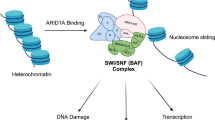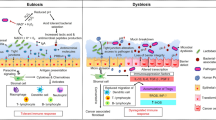Abstract
Purpose
Cervical cancer is an important health issue among women worldwide. Cervical smear and human papillomavirus detection are the most used screening methods to detect preneoplastic and neoplastic lesions. However, as neither can predict cervical development, new markers are needed for this disease. ZNF516, a potential tumor suppressor gene, has been found altered in cervical cancer. The objective of this study was to determine ZNF516 immunohistochemistry frequency in cervical biopsies and its association with clinicopathological parameters, to evaluate its potential as marker in cervical lesions.
Methods
A retrospective series of 452 formalin-fixed, paraffin-embedded (FFPE) cervical biopsies, obtained between 2002 and 2007, were selected for immunohistochemistry of ZNF516, p16 and Ki-67 markers. Human papillomavirus genotyping was performed on 272 of these samples through reverse line blot assay.
Results
An inverse relation between ZNF516 expression and cervical lesions grade (P < 0.001) was observed, given this protein was found mainly expressed in normal tissues, while was decreased in cervical lesions. As expected, the proliferation markers p16 and Ki-67 were found highly expressed in cervical cancer compared to normal tissues, and inversely correlated to ZNF516 expression (P < 0.01). High oncogenic risk-Human papillomavirus presence also was related to the lack of ZNF516 expression in cervical lesions (P < 0.05), and the detection of these two parameters showed a high sensitivity (70.9%) for preneoplastic lesions detection.
Conclusions
The loss of ZNF516 expression was found in cervical lesions, and its detection potentially could be used as a complementary marker of early diagnosis in cervical lesions.





Similar content being viewed by others
References
Bray F, Ferlay J, Soerjomataram I et al (2018) Global cancer statistics 2018: GLOBOCAN estimates of incidence and mortality worldwide for 36 cancers in 185 countries. CA Cancer J Clin 68:394–424. https://doi.org/10.3322/caac.21492
Herrero R, González P, Markowitz LE (2015) Present status of human papillomavirus vaccine development and implementation. Lancet Oncol 16:e206–e216. https://doi.org/10.1016/S1470-2045(14)70481-4
Nayar R, Wilbur DC (2015) The Pap test and Bethesda 2014. Cancer Cytopathol 123:271–281. https://doi.org/10.1002/cncy.21521
Woodman CB, Collins S, Winter H et al (2001) Natural history of cervical human papillomavirus infection in young women: a longitudinal cohort study. Lancet 357:1831–1836. https://doi.org/10.1016/S0140-6736(00)04956-4
Mayrand M-H, Duarte-Franco E, Rodrigues I et al (2007) Human Papillomavirus DNA versus Papanicolaou Screening Tests for cervical cancer. N Engl J Med 357:1579–1588. https://doi.org/10.1056/NEJMoa071430
Rositch AF, Koshiol J, Hudgens MG et al (2013) Patterns of persistent genital human papillomavirus infection among women worldwide: a literature review and meta-analysis. Int J Cancer 133:1271–1285. https://doi.org/10.1002/ijc.27828
Valenti G, Vitale SG, Tropea A et al (2017) Tumor markers of uterine cervical cancer: a new scenario to guide surgical practice? Updates Surg 69:441–449. https://doi.org/10.1007/s13304-017-0491-3
Darragh TM, Colgan TJ, Cox JT et al (2012) The Lower Anogenital Squamous Terminology Standardization Project for HPV-associated lesions: background and consensus recommendations from the College of American Pathologists and the American Society for Colposcopy and Cervical Pathology. Arch Pathol Lab Med 136:1266–1297. https://doi.org/10.5858/arpa.LGT200570
Galgano MT, Castle PE, Atkins KA et al (2010) Using biomarkers as objective standards in the diagnosis of cervical biopsies. Am J Surg Pathol 34:1077–1087. https://doi.org/10.1097/PAS.0b013e3181e8b2c4
Gajanin Z, Vilendecic R, Ecim-Zlojutro V et al (2015) Significance of immunohistochemical expression of p16INK4a in the differentiation of inflammatory and preneoplastic cervical lesions. Srp Arh Celok Lek 143:42–49. https://doi.org/10.2298/SARH1502042G
Burrell RA, McClelland SE, Endesfelder D et al (2013) Replication stress links structural and numerical cancer chromosomal instability. Nature 494:492–496. https://doi.org/10.1038/nature11935
Brebi P, Maldonado L, Noordhuis MG et al (2014) Genome-wide methylation profiling reveals Zinc finger protein 516 (ZNF516) and FK-506-binding protein 6 (FKBP6) promoters frequently methylated in cervical neoplasia, associated with HPV status and ethnicity in a Chilean population. Epigenetics 9:308–317. https://doi.org/10.4161/epi.27120
Guerrero-Preston R, Valle BL, Jedlicka A et al (2016) Molecular Triage of premalignant lesions in liquid-based cervical cytology and circulating cell-free DNA from urine, using a panel of methylated human papilloma virus and host genes. Cancer Prev Res 9:915–924. https://doi.org/10.1158/1940-6207.CAPR-16-0138
Zhong P, Li J, Gu Y et al (2015) P16 and Ki-67 expression improves the diagnostic accuracy of cervical lesions but not predict persistent high risk human papillomavirus infection with CIN1. Int J Clin Exp Pathol 8:2979–2986
Ili CG, Brebi P, López J et al (2011) Genotyping of human papillomavirus in cervical intraepithelial neoplasia in a high-risk population. J Med Virol 83:833–837. https://doi.org/10.1002/jmv.22057
Roa JC, Garcia P, Gomez J et al (2009) HPV genotyping from invasive cervical cancer in Chile. Int J Gynecol Obstet 105:150–153. https://doi.org/10.1016/j.ijgo.2008.12.017
Goodman A (2015) HPV testing as a screen for cervical cancer. BMJ 350:h2372–h2372. https://doi.org/10.1136/bmj.h2372
Dostal A, Nemeckova J, Gaillyova R et al (2006) Identification of 2.3-Mb gene locus for congenital aural atresia in 18q22.3 deletion: a case report analyzed by comparative genomic hybridization. Otol Neurotol 27:427–432
Fang J, Zhang H, Jin S (2014) Epigenetics and cervical cancer: from pathogenesis to therapy. Tumor Biol 35:5083–5093. https://doi.org/10.1007/s13277-014-1737-z
van Baars R, Griffin H, Wu Z et al (2015) Investigating diagnostic problems of CIN1 and CIN2 associated with high-risk HPV by combining the novel molecular biomarker PanHPVE4 with P16INK4a. Am J Surg Pathol 39:1518–1528. https://doi.org/10.1097/PAS.0000000000000498
Miyamoto S, Hasegawa J, Morioka M et al (2016) The association between p16 and Ki-67 immunohistostaining and the progression of cervical intraepithelial neoplasia grade 2. Int J Gynecol Obstet 134:45–48. https://doi.org/10.1016/j.ijgo.2015.12.005
Toll AD, Kelly D, Maleki Z (2014) Utility of P16 expression and Ki-67 proliferation index in ASCUS and ASC-H pap tests. Diagn Cytopathol 42:576–581. https://doi.org/10.1002/dc.23076
Clifford GM, Smith JS, Plummer M et al (2003) Human papillomavirus types in invasive cervical cancer worldwide: a meta-analysis. Br J Cancer 88:63–73. https://doi.org/10.1038/sj.bjc.6600688
Burgers WA, Blanchon L, Pradhan S et al (2007) Viral oncoproteins target the DNA methyltransferases. Oncogene 26:1650–1655. https://doi.org/10.1038/sj.onc.1209950
Santos ALF, Derchain SFM, Sarian LO et al (2006) Performance of Pap smear and human papilloma virus testing in the follow-up of women with cervical intraepithelial neoplasia grade 1 managed conservatively. Acta Obstet Gynecol Scand 85:444–450. https://doi.org/10.1080/00016340600604682
Swets JA (1988) Measuring the accuracy of diagnostic systems. Science 240:1285–1293. https://doi.org/10.1126/science.3287615
Acknowledgements
Fondo Nacional de Desarrollo Científico y Tecnológico de Chile (FONDECYT) nos. 3130630, 11150622, 11150802, 3180550 and 3170826; Fondo de Financiamiento de Centros de Investigación en Áreas Prioritarias no. 15130011; The Millennium Institute on Immunology and Immunotherapy no. P09-016-F.
Author information
Authors and Affiliations
Contributions
Protocol/project development, data collection or management, data analysis and manuscript writing/editing. CI: project development, data management, data analysis and Manuscript writing. JL: protocol development, data collection and manuscript editing. KB: data analysis and manuscript editing. IR: data analysis and manuscript editing. JR: data collection and manuscript editing. LZ: data analysis and manuscript editing. BM: data collection and manuscript editing. CV: data collection and manuscript editing. JCR: data collection and management and manuscript. PB: project development, data management, data analysis and manuscript writing editing.
Corresponding author
Ethics declarations
Conflict of interest
The authors declare that they have no conflict of interest.
Ethical approval
All procedures performed in studies involving human participants were in accordance with the ethical standards of the institutional and/or national research committee and with the 1964 Helsinki declaration and its later amendments or comparable ethical standards. This research is a retrospective study including biopsy tissue samples of archive. Therefore, for this type of study formal consent is not required. The use of these samples was approved by the ethical scientific committee of School of Medicine (Document no. 17/012), Universidad de La Frontera, Temuco, Chile.
Informed consent
This research is a retrospective study including biopsy tissue samples of archive. Therefore, for this study informed consent was not obtained. The use of these samples was approved by the ethical scientific committee of School of Medicine (Document no. 17/012), Universidad de La Frontera, Temuco, Chile.
Electronic supplementary material
Below is the link to the electronic supplementary material.
Rights and permissions
About this article
Cite this article
Ili, C., Lopez, J., Buchegger, K. et al. Loss of ZNF516 protein expression is related with HR-HPV infection and cervical preneoplastic lesions. Arch Gynecol Obstet 299, 1099–1108 (2019). https://doi.org/10.1007/s00404-018-5012-1
Received:
Accepted:
Published:
Issue Date:
DOI: https://doi.org/10.1007/s00404-018-5012-1




